► Porsche’s 2015 return to Le Mans
► Inside the motorsport garage
► Your fly-on-the-wall guide
Saturday 13 and Sunday 14 June was to be 2020’s Le Mans weekend – supposedly the last of the current class system. The coronavirus pandemic, however, put a blocker on that, with the event being postponed until 19-20 September 2020. While the event is still going ahead this year, we thought we’d bring you a slice of Le Mans cake to chow down on until then.
Enjoy.
86,400 seconds to glory…
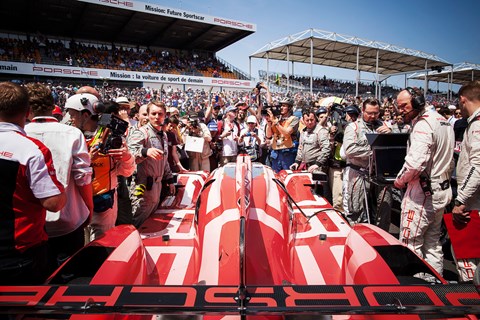
Goodness it’s crowded in here. There are 25 mechanics in the garage, each wearing expressions of focused calm, each uniformed, and they move around like the well-oiled machine they’re here to fettle. The air is thick with mechanical smells, the echoey excitement of a massive crowd outside, and a deep, rich sense of expectation. For this is the year that Porsche want to win Le Mans for the first time in 17 years, having failed on their return last year, and these are the guys charged with delivering that goal.
And in the corner, right at the back, there’s me, watching it all unfold like a live drama. I’ve got 24 hours to practice the art of not getting in the way. I’m sweating more than they are.
Only when you’ve witnessed the prolonged periods of intensity that make Le Mans the challenge it is, do you understand the race’s allure. Everyone has their own Everest to climb and until they’ve reached their summit, quitting isn’t an option.
Porsche reached the pinnacle in 1970, when Dickie Attwood and Hans Herrmann took win number one in the iconic short-tailed 917. The company has continued to come back because the Porsche legend was born at Le Mans and every victory has further immortalised the brand. That’s why Porsche opted for sportscars over Formula One when they decided to return to top-level motorsport in 2014.
‘It’s not an F1 car,’ says F1 star Nico Hulkenberg, who’s been drafted in to lead the team’s third car. ‘But it’s not far off F1 in terms of grip and power, which makes it fun to drive. You need to find a good rhythm and the great thing about the tyres is that you’re able to push every single lap.’
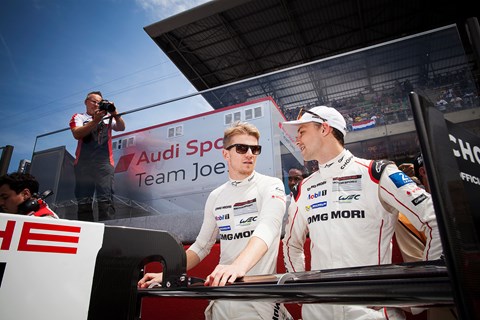
A closer look at the 919 Hybrid’s tech reveals that victory was always on the cards this year, if only they could make the car reliable. The 919 regenerates 8MJ of electrical energy per lap, which is more than key rivals Audi and Toyota, but its advantages are track-specific. Le Mans is the only circuit on the World Endurance Championship calendar that’s long enough to allow the car to regenerate all 8MJ, which highlights where Porsche’s priorities lie.
‘The car is very quick around Le Mans,’ says Mark Webber, now in his second season at Porsche after quitting F1. ‘We saw that from the first lap at the test. But we also knew that Audi would be quick in race trim, so we took nothing for granted. The difference between being in the lighthouse or sh*thouse at this race is very small; you need to be very disciplined and have a little bit of luck.’
You need luck because there are so many opportunities for things to go wrong. The cars are stressed at Le Mans like nowhere else; they make more than 25,000 seamless-shift gearchanges during the race, each one involving the cog being rammed home in less than 0.1sec, and the 3300 racing miles are hard ones. The long-life Michelin tyres allow the drivers to push every lap, smashing the car over the kerbs time and again.
Then there’s traffic. Pole position this year was 48sec faster than the slowest GT car, which creates closing speeds between LMP1 and GT of up to 70mph. If the GTs haven’t seen the faster cars, the smallest of misunderstandings can result in contact that takes both cars out of the race. Concentration is as important as race-craft round here. One lapse and it’s over.
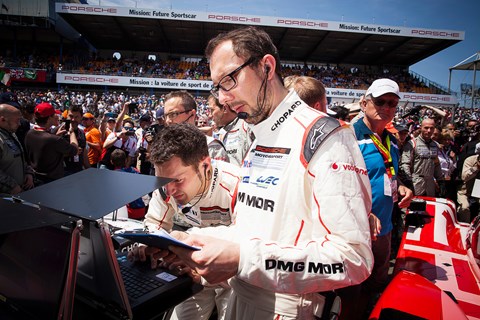
The roads leading to Le Mans are a mess on race day. More than 50,000 Brits are blocking the main arteries from Calais, and 200,000 other race-goers are clogging up the Routes Nationales. Even those people arriving by air have no guarantee of a smooth arrival. For a period of six hours the airfield adjacent to the start-finish straight is busier than Heathrow; everywhere you look there is traffic chaos.
But it’s happy chaos. People of different nationalities share coffees and sandwiches, and Porsche take the first PR victory of the weekend by handing out free merchandise. Photographs of 919 Hybrids are soon trading like Panini stickers.
‘Porsche 1-2-3 sur la grille de depart’ are the newspaper headlines, but the team is keeping the pace of its cars in perspective. ‘It’ll give us an advantage into Turn 1,’ says Webber, the lead driver of car no.17, ‘but this is a 24-hour race. All you want to do is get around Turn 1; it doesn’t really matter where.’
As the 3pm start-time approaches, tension in the Porsche garage rises; everyone – from gaffer Wolfgang Hatz down – shows signs of nerves. It’s a welcome shot of adrenaline because it’s already been a long week. Practice and qualifying on Wednesday and Thursday nights, followed by thorough race preparations; this morning’s 9am warm-up session ensures everyone is out of bed at dawn, ahead of 24 hours of racing.
‘I think we have a race on our hands,’ says Hulkenberg, who can’t wipe the smile off his face. He’s relishing the cars and the level playing field provided by the LMP1 rules: the cars are a minimum weight of 870kg, which is 168kg heavier than an F1 car, so Hulkenberg’s 74kg frame is at less of a disadvantage than it is in F1.
‘There’s been a lot to get used to,’ he adds, ‘but the car is fun to drive. The biggest differences with F1 are the [lack of] visibility from the cockpit and the [Michelin] tyres. You can push on them for lap after lap, which is something I’m not used to. I’m also looking forward to driving at night; I enjoyed that during testing and it should be even more fun on this track.’
With such a long race in prospect, Porsche has assembled a ‘snoozebox’ at the back of the paddock. Each driver has his own room, although they are pretty sparse – each is equipped with a metal bed and a thin mattress, and not much more. There are also rest areas for other team members.
The start ceremony begins at 2pm, one hour before the off. The mechanics push the cars from the garage onto the grid, where they are lined up in a traditional fan formation. VIPs are two-a-penny: French president Francois Hollande causes the biggest stir, moving stealthily around the grid in a gaggle of security men.
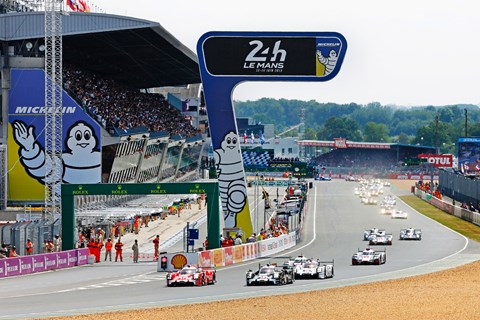
The drivers pose for selfies, suck at their drinks’ bottles and fidget. There’s a jumpiness to them that isn’t evident at more conventional races, but such is the sense of occasion at Le Mans. The prize is bigger, albeit not fiscally because the winning car gets just €40,000. The risks are also greater than elsewhere, and no-one knows that better than Webber. On his first visit to Le Mans in 1999 he cartwheeled out of the race warm-up after a catastrophic aerodynamic malfunction. ‘You don’t want to be looking at the sky here,’ he says with a wry smile.
With half an hour to go, the grid begins to clear. The drivers who are starting the race get kitted up; everyone else, except the scattering of mechanics needed to start the car, returns to the pits, where each person has a designated place to stand or sit.
A new nose for each car sits in the pit garage and there are a host of other spares in a makeshift garage in the paddock. There’s a spare chassis, six engines, six front gearboxes, six rear gearboxes, nine more front wings, nine rear wings and 80 wheels rims. The magnesium rims have been stacked carefully because they are expensive, but with reason. They have saved 20kg compared to the aluminium rims used last year.
At 3pm on the dot, pole-man Neel Jani leads the field across the start-finish straight. President Hollande waves a Tricolore to get the race underway, amid roars of delight in the grandstands. But the Porsche garage remains calm. There are a few nervous ramblings in German between the mechanics, but most people watch the TVs in silence, looking out for signs of trouble. At this stage of the race it’s clear that a fear of failure motivates the team rather than the lure of success.
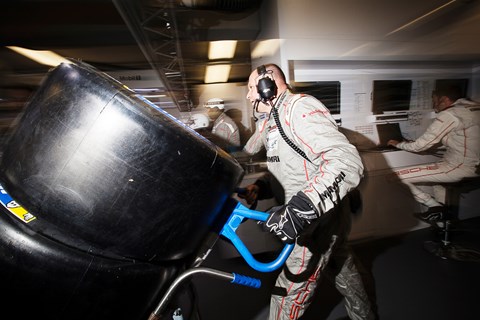
When the cars pass the pits at the end of lap one, the mechanics are stood down. The message is relayed to them via radio and they relax by sitting on tool chests or in deck chairs; everyone is now waiting for the first re-fuelling stops on lap 13 (total: 30 for the race). Some walk to the kitchen at the back of the pit for a drink or a biscuit.
Over the radio, the engineers regularly ask the drivers about any set-up changes that might be needed at the next pitstop. All pits-to-car radio conversations are spoken in English and they’re brief.
‘More turn-in please.’
‘Copy.’
The pitstops are super-efficient. Only when the cars are stationary are the mechanics allowed into the pitlane, but no more than two at a time. The pair changing tyres work around the car with the choreography of two ballet dancers, one working the gun and the other the wheels. If there’s no driver change, a separate mechanic replaces his drinks’ bottle later on and, when necessary, he rips off the windscreen’s tear-off.
As the car accelerates back into the pitlane, the tyre changers usually embrace or high-five to celebrate a job well done. Unbelievably, given the intensity of the moment, they rarely make a mistake, but Porsche still rotates the pairs to give them time off.
So far, so good, but you have to expect the unexpected at Le Mans. ‘You have to react to what’s going on around you,’ says Porsche technical director Alex Hitzinger. ‘You can’t rely on the computer; you need to make decisions on the pitwall, which is one of the many great things about this race.’
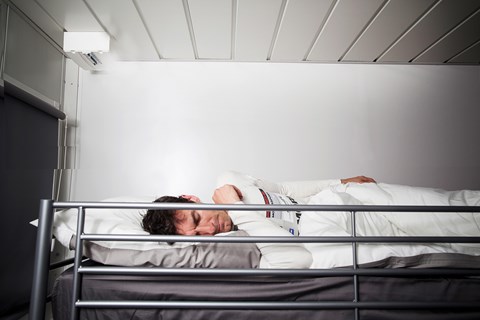
During the early hours of Sunday, Webber has to react to the unexpected as well. ‘I was gunning it around the Porsche Curves and I almost hit a squirrel,’ he said. ‘You’re on a pretty fixed line there, so it took an effort to miss him. I was worried about his heart rate for a while, but I missed him. He got away.’
In the end, the car with the blemish-free race is victorious. Hulkenberg guides the no.19 car over the line, completing a total of 8hrs 52mins behind the wheel – the most of the three winning drivers. But each has played his part: Briton Nick Tandy was majestic during the night and Kiwi Earl Bamber has been equally formidable during his two quadruple stints. The car runs faultlessly, bar a precautionary engine cover and rear wing change on Sunday morning, and it’s won the race at an average speed of 139mph. Hulkenberg claims that the victory, his first since racing in GP2 in 2009, is the greatest achievement of his career. ‘If I don’t get a serious offer in F1 next year, I would think about sportscars, yes,’ he says.
Technically the no.17 car of Webber, Hartley and Timo Bernhard is also faultless, but a yellow flag infringement by Brendon Hartley and subsequent one-minute penalty ends their intra-team challenge and by mid-morning Sunday the finishing order is set.
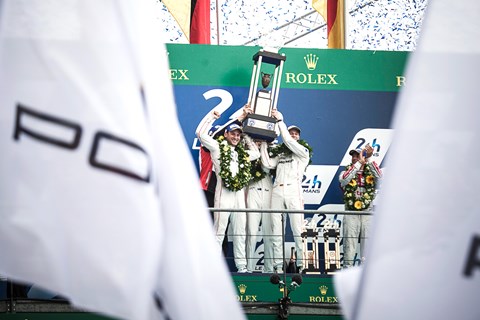
There are post-race hugs all round, and some tears. People feel worn out when the adrenaline stops and there are more tears when Dr Porsche makes an emotional speech to the throng of VIPs. Then it’s party time: ‘Tonight’s gonna be a good night’ blares out of the speakers and people embark on what looks like a second sleepless night. For the hospitality guys and gals, as well as the 16 chefs working behind the scenes, their work is not yet done.
But there’s no sign of the drivers. After the podium celebrations and a press conference they are summoned by Hitzinger to the engineering truck. He wants to congratulate them and to have an initial look ahead to next season’s car.
‘Yep, we’ve already had 15 minutes talking about next year’s car,’ says Webber. ‘That’s a bit [Adrian] Newey-esque, but that’s what it’s all about. There’s an F1 mentality to this team now, which is great to see. We are strong, but we need to get stronger because we have weaknesses. There will be another step made by everyone next year and we need to make sure we’re at the forefront of that.’
As I leave the garage, exhausted, it feels like I’m about the only one who’ll bask in what’s been achieved here in the last 24 hours. Everyone else is too busy planning for 2016.